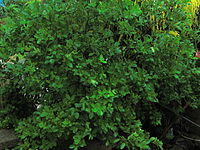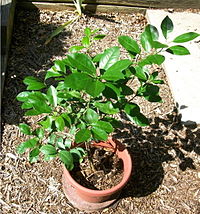- Calamondin
-
Calamondin
×Citrofortunella microcarpa
Calamondin fruit and leaves Scientific classification Kingdom: Plantae (unranked): Angiosperms (unranked): Eudicots (unranked): Rosids Order: Sapindales Family: Rutaceae Genus: ×Citrofortunella Species: ×C. mitis Binomial name ×Citrofortunella mitis
(Bunge) Wijnands[1]Synonyms Citrus microcarpa
× Citrofortunella microcarpa, the Calamondin or Calamansi, is a fruit tree in the family Rutaceae, commonly called the calamondin, golden lime, panama orange, chinese orange, acid orange, calamonding, or calamandarin in English.[1] It is believed to originate from China and has spread throughout Southeast Asia, India, Hawaii, the West Indies, Central and North America.[2] The plant is characterized by wing-like appendages on the leaf stalks and white or purplish flowers. Its fruit has either a spongy or leathery rind with a juicy pulp that is divided into sections.
The fruit is indigenous and widely cultivated in the Philippines (Tagalog: calamansi or kalamansî (kɐlɐmɐnˈsɪʔ); Visayan: limonsito or simuyaw ), Calamansi is available year round in the Philippines and is usually seen in its unripened state as a dark green fruit, but if left to ripen it turns a tangerine orange color.
Contents
Distribution
The tree is the result of a hybrid between species in the genus Citrus and an unknown in the wild. It is generally held that most species in cultivation are ancient apomictic hybrids and selected cultivars of these hybrids, including crosses with segregate 'citrus' genera such as Fortunella and Poncirus. Hybrids between Citrus genera and species have been cultivated for so long that the origins of most are obscure. The Calamondin is sometimes described as a hybrid 'native' to the Philippines or Southeast China.
The calamondin is a cross between Citrus reticulata (Mandarin orange group) and Fortunella japonica (Kumquat group).[2] The calamondin is treated as an intergeneric hybrid in the nothogenus ×Citrofortunella as ×Citrofortunella microcarpa. [1]
Description
Citrofortunella microcarpa is a shrub or small tree growing to 3–6 metres (9.8–20 ft). The fruit of the calamondin resembles a small, round lime, usually 25-35mm in diameter, but sometimes up to 45mm. It has the orange color of a tangerine with a very thin green or orange colored peel.
Uses
Culinary
The Calamondin bears a small citrus fruit that is used to flavor foods and drinks. Despite its outer appearance and its aroma, the taste of the fruit itself is quite sour, although the peel is sweet. Eating a whole fruit has a surprise with the combination of sweet and sour. Calamondin marmalade can be made in the same way as orange marmalade. Like other citrus fruits, the calamondin is high in vitamin C.[3]
The fruit can be frozen whole and used as ice cubes in beverages such as tea, soft drinks, water, and cocktails. The juice is extracted by crushing the whole fruit, and makes a flavorful drink similar to lemonade. A liqueur can be made from the whole fruits, in combination with vodka and sugar. In Asian cuisines, the juice is used to season fish, fowl, and pork. It is commonly used as a condiment in Filipino dishes like Pancit.[3] [4]
Cultivation
In North America, ×Citrofortunella microcarpa is grown primarily as an ornamental plant in gardens, and in pots and container gardens on terraces and patios. The plant is especially attractive when the calamondin fruits are present.
The plant is frost sensitive and therefore limited outdoors to frost-free climates (such as Florida, coastal California, south Texas, and Hawaii in the United States). Potted plants are brought into a greenhouse, conservatory, or indoors as a houseplant during the winter periods in regions with cooler climates. [5]
However in its native homeland of Southeast Asia, the Calamondin is easy to cultivate. The plant grows well in cool and elevated areas and in sandy soils rich in organic matter. Waterlogged areas are not suitable for cultivation because calamansi plants cannot tolerate too much moisture. Calamansi can be propagated by seeds using its vegetative parts. To produce big, luscious fruits, applying fertilizer, such as ammonium sulfate or urea, around each tree one month after planting is essential. The trees will start to bear fruit one or two years after planting. Trees have an average life span of five years.
Medicine
Calamondin citrus has found several medicinal uses. When rubbed on insect bites, the juice will relieve the itching and reduce the irritation. It can also be used as a natural acne medicine or taken orally as cough medicine (often mixed with green tea), and is a natural anti-inflammatory. For problems with constipation the juice is warmed and diluted with water. It bleaches freckles and helps to clear up acne vulgaris and pruritus vulvae.[6][7] In Malaysia, it is used as an antidote for poison, and a poultice of pandanus leaves mixed with salt and the juice of citrus microcarpa, can be used to treat abscesses. In Malaya, it is combined with pepper to help expel phlegm. Its root is used in the Philippines at childbirth.
Other
In its unripened state it additionally finds use as a hair conditioner, a body deodorant, an ink stain remover for fabrics and other purposes as described above.
See also
References
- ^ a b c (2008-10-07). "×Citrofortunella microcarpa (Bunge) Wijnands". Germplasm Resources Information Network. Accessed on 2011-05-05.
- ^ a b Morton, J. (1987). "Calamondin". New Crop Resource Online Program.
- ^ a b "Calamondin: The Miniature Orange". Oliodigest.com.
- ^ Calamondin halves or quarters may be served with iced tea, seafood and meats, the acid juicet is often employed like lime or lemon juice to make gelatin salads or desserts, custard pie or chiffon pie. In the Philippines, the extracted juice, with the addition of gum tragacanth as an emulsifier, is pasteurized and bottled commercially
- ^ Mabberley, D.J. 1987. The Plant Book. A portable dictionary of the higher plants. Cambridge University Press, Cambridge. 706 pp. ISBN 0-521-34060-8.
- ^ "Calamondin - The Most Versartile Fruit". Aggie Horticulture. Retrieved on 2011-05-31.
- ^ "Kalamansi". Philippine Medicinal Plants. Retrieved on 2011-05-31.
External links
- Oliodigest: Calamondin, the Miniature Orange
- Calamondin - The Most Versartile Fruit at Aggie Horticulture.
Categories:- Hybrid Citrus
- Citrus
- Flora of the Philippines
- Flora of China
- Philippine ingredients
- Asian cuisine
- Fruits originating in Asia
- Garden plants of Asia
- Ornamental trees
Wikimedia Foundation. 2010.


